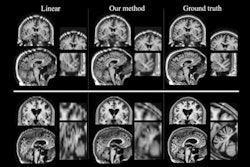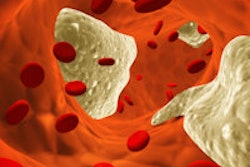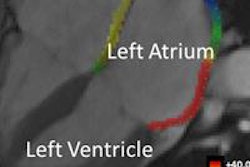
Asymptomatic patients may have triple the risk of stroke and death if they have brain lesions smaller than 3 mm on 1.5-tesla MRI, a new study concludes. Furthermore, if the patients also have lesions 3 mm or larger, they may face an eightfold increase in stroke risk.
The findings, published in the July 7 issue of the Annals of Internal Medicine, come from researchers at the University of Mississippi Medical Center and other U.S. institutions. The group encouraged clinicians not to dismiss the possible adverse effects of such small lesions.
 Dr. B. Gwen Windham from University of Mississippi Medical Center.
Dr. B. Gwen Windham from University of Mississippi Medical Center."These results potentially will help us better understand early pathological changes that develop in the arterial system in the brain," lead author Dr. B. Gwen Windham, an associate professor of medicine in the division of geriatric medicine, told AuntMinnie.com. "It also is a step toward understanding the risk, what these lesions mean, and what we need to do about them clinically in the future."
Previous research supports the notion that lesions 3 mm or larger are associated with a greater risk of stroke and death. Even in asymptomatic people, there is an increased risk of developing dementia and gait problems as they age.
But one major clinical question is determining when the pathological process begins.
At 1.5-tesla MRI, "there has been some concern ... whether we could call what we see a lesion," Windham said. "Is it a lesion? Is it space around an artery, some subtle thing that may or may not be clinically important, or something pathological? We really didn't know. I think that's why [clinicians] drew the line at 3 mm, because they were more confident about what they were seeing at sizes of 3 mm or larger."
Therefore, the purpose of this new study was to examine the association between incident stroke and stroke-related mortality and lesion size: smaller than 3 mm, 3 mm or larger, or both.
"To our knowledge, this is the first study to focus on the smallest lesions and associations with these clinical outcomes," Windham said.
ARIC study
The researchers reviewed data from 1,884 subjects in the Atherosclerosis Risk in Communities (ARIC) study, which followed participants over a couple of decades to gather information on cardiovascular and cerebrovascular diseases and document clinical outcomes.
ARIC participants were between the ages of 50 and 73 and were from Forsyth County, NC, and Jackson, MS. They were invited to undergo brain MRI between 1993 and 1995 as the first step in the longitudinal study. Subjects received scans on a 1.5-tesla MRI system with an imaging protocol that included T1-weighted, T2-weighted, and proton density-weighted imaging of the whole brain.
Windham and colleagues recorded the number of lesions smaller than 3 mm and those at least 3 mm in size (Ann Intern Med, July 7, 2015, Vol. 163:1, pp. 22-31).
The average follow-up in the study was 14.5 years. During the follow-up period, there were 157 clinical strokes, 50 stroke-related deaths, and 576 all-cause deaths. The majority of strokes (89%) were ischemic. Among patients without stroke, 90% had more than 10 years of follow-up.
Increased stroke risk
Compared with people with no lesions, subjects with lesions smaller than 3 mm had triple the risk of incident stroke (hazard ratio [HR] = 3.47), and those with lesions at least 3 mm in size had double the risk (HR = 1.94). Meanwhile, when subjects had both types of lesions, the risk of incident stroke was eight times as great (HR = 8.59).
For hemorrhagic stroke, having lesions smaller than 3 mm or lesions of both sizes increased risk, but these results were less precise because of the low incidence of this type of stroke.
The size and number of lesions were also associated with the risk of death, the researchers found.
| Hazard ratios by lesion size | ||
| Size | Stroke-related death | All-cause death |
| Lesions < 3 mm | 3.05 | 1.34 |
| Lesions ≥ 3 mm | 1.87 | 1.90 |
| All lesions | 6.97 | 1.89 |
Compared with no lesions, the presence of one or two small lesions increased the risk of stroke (HR = 4.87) and stroke-related death (HR = 5.87) roughly fivefold. The same stroke risk was seen with the presence of more than two lesions smaller than 3 mm (HR = 5.72), while the risk of stroke-related death could not be determined.
'Conservative' results
Windham and colleagues noted that their findings may be "conservative," given the use of 1.5-tesla MRI and the "potential misclassification of lesions smaller than 3 mm due to lower pixel resolution," citing both factors as potential study limitations. "Newer high-definition imaging might improve classification of lesions smaller than 3 mm and should be examined in future studies to confirm our results," they wrote.
Even so, the "robust associations between lesions smaller than 3 mm and stroke and stroke-related mortality support the hypothesis that very small lesions are pathologic and clinically important," they added.
Windham said the findings have not changed the imaging protocols at the medical center because more definitive research is needed.
"One question we have is: Is this all one linear pathological process, where we start with these very tiny lesions, which get bigger?" she said. "Or are there different pathways that contribute to diseases in the arterial tree? We don't know that yet for these very small lesions."
Still, clinicians need to take the presence of lesions smaller than 3 mm seriously, she added.
"Even these very small changes we see on imaging may be clinically important," Windham said. "We need to do more work to better understand how they develop, why they develop, and what we can do to reduce the clinical risk associated with having these lesions."
The researchers plan to continue their work in this area, especially given the advances in magnet strength since the MRI scans for the ARIC study were conducted in the mid-1990s.
"We do have newer technology," she said. "Maybe we could try to understand better what these smaller lesions mean."
The group may also explore whether these lesions carry other risks.
"For example, the larger lesions are associated with the development of dementia as a person ages," Windham said. "If people have lesions larger than 3 mm, even asymptomatic persons, they are still at greater risk for developing dementia and mobility problems. We don't know if that is the case with the smaller lesions, but I think that would be an interesting area of study."




















